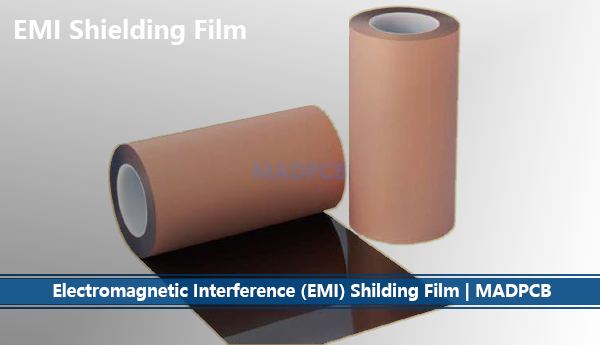Table of Contents
Why EMI Shielding Film in FPC and Rigid-Flex PCB?
Electromagnetic Interference (EMI), also referred to Radio-Frequency Interference (RFI), when in the radio frequency spectrum, is a disturbance generated by an external source that affects an electrical circuit on printed circuit boards by electromagnetic induction, electrostatic coupling, or conduction. This disturbance can degrade the performance of your PCB assembly or even stop it from functioning.
Shielding can be different materials based on the application but must features conductivity and grounding. When your flex PCB or flex-rigid PCB application requires limits in electromagnetic and/or electrostatic interference, EMI shielding should be applied. The shielding will be different upon the amount of EMI interface in the product, the conductivity requirements and the amount of flexing that the circuit will endure. With ever-increasing wireless communication networks in the form of mobile phones, earphones and wireless printers, EMI is becoming from many different sources even outside of the device to disrupt electronic devices, equipment and systems. Thus, EMI shielding should be considered when necessary.
EMI Performance: Copper Plating, Metal Housing, Silver Ink &EMI Shielding Film
EMI shielding is to absorb radio and other EMI waves. EMI is increasingly becoming a problem today, how to choose the best EMI shielding method? EMI shielding methods in FPCs can be copper plating, conductive silver ink printing and EMI shielding film bonding.
- Copper Plating: copper plating is a traditional shielding method, which is typically used in the manufacturing of FPCs before. while copper is not ideal for applications that require high flexibility, often cracking when the circuit is bent or folded, or burring during the die punching process. Thin cross-hatched copper layers would be a good choice for multilayer flex PCBs.
- Conductive Silver Ink: silver ink is a good EMI shielding method. Metal silver ink and coating technique nowadays can guarantee the clean and proper functioning of high-frequency on-board chips and their ultra-fast data transmission. Conductive silver ink is also sometimes used in flex PCB designs, but its cost is the most expensive among these 4 methods, and its processing takes the longest time.
- Metal Housing: metal housing is a classic EMI shielding method, mainly used on rigid PCB boards and rarely used on flex circuits. In FPCs, it seems obsolete since it doesn’t meet the requirements of miniaturization. Electronics gets smaller, metal housing doesn’t work on such a tiny scale. Besides, if using metal housing, the specific areas of the FPC will lose its flexibility.
- EMI Shielding Film: EMI shielding film is becoming more and more popular in the designs of flexible PCB and rigid-flex board. With EMI shielding film design, the flex PCB has the best flexibility as well as the thinnest overall thickness. Compared to silver ink printing and copper layer design, the flex PCB cost will be lower, and the shielding capability will be in a higher degree.
EMI shielding film has various advantages in shielding performance, flexibility, cost and processing lead time. EMI shielding film improves shielding performance for the transmission of high-frequency signals and high flexibility so circuits do not break when bent, it can replace the copper layer design, then to save cost without compromising on the flexibility of the board.
EMI Shielding Film Applications in Flexible and Rigid-Flex PCB Designs
For controlling EMI, in some flex circuit applications, designers always add EMI shielding Film. Many electronic devices that utilizing flexible circuit and rigid-flex PCB are sensitive to either absorbing or emitting EMI. If EMI is left uncontrolled, it can negatively impact the performance of the design and in extreme cases completely prevent it from functioning. Here are some applications with EMI shielding film:
- Magnetic Resonance Imaging (MRI)
- Infusion Pumps
- Patient Monitoring Systems
- Mobile Phone
- PC &Tablet
- Earphone
- GPS
- Network Hardware
- Military Devices
If you are familiar with PCB and assembly manufacturing, you can always see a black film bonded to the flexible and rigid-flex printed circuit boards. What’s this film? It’s an EMI shielding film. E.g. In the material roll of TATSUTA SF-PC5000/-C, this EMI film has a 5-layer construction, from top to bottom, consisting of transfer film (PET) layer, insulation layer, metallic deposition layer, conductive adhesion layer and protection layer (PET). The insulation layer is black as well as friction resistant. Thus, it seems black.
How to Bond EMI Film?
- Cutting the EMI as dimensional requirement
- Removing the protection layer on its bottom
- Stacking it at the right location on flex circuit
- Laminating them together under heat and pressure
The conductive adhesive flows and connects the metallic deposition layer to the copper circuitry on PCB, then to form the electrical connection as ground.

